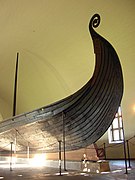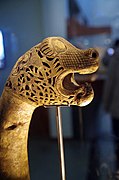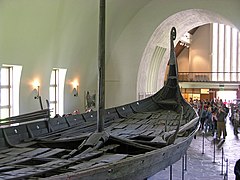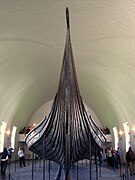Viking Ship Museum (Oslo)
Vikingskipshuset på Bygdøy | |
 | |
| Location | Bygdøy,Oslo,Norway |
|---|---|
| Coordinates | 59°54′17.12″N10°41′4.06″E/ 59.9047556°N 10.6844611°E |
| Website | www |

TheViking Ship Museum(Norwegian:Vikingskipshuset på Bygdøy) is located on theBygdøypeninsula inOslo,Norway.It will be temporarily closed from September 2021 until 2027.[1]
It is part of theMuseum of Cultural Historyof theUniversity of Oslo,and houses threeVikingera burial ships that were found as part ofarchaeologicalfinds fromTune,Gokstad (Sandefjord), Oseberg (Tønsberg) and theBorre mound cemetery.[2]
Attractions[edit]
The museum is most famous for the completely wholeOseberg ship,excavated from the largest knownship burialin the world. Other main attractions at the Viking Ship Museum are theGokstad shipandTune ship.Additionally, theViking Agedisplay includes sledges, beds, a horse cart, wood carving, tent components, buckets and othergrave goods.[3]
History[edit]
In 1913, Swedish professorGabriel Gustafsonproposed a specific building to houseViking Agefinds that were discovered at the end of the 19th and the beginning of the 20th century. The Gokstad and Oseberg ships had been stored in temporary shelters at the University of Oslo. An architectural contest was held, andArnstein Arnebergwon.
The hall for the Oseberg ship was built with funding from theParliament of Norway,and the ship was moved from the University shelters in 1926. The halls for the ships from Gokstad and Tune were completed in 1932. Building of the last hall was delayed, partly due to theSecond World War,and this hall was completed in 1957. It houses most of the other finds, mostly from Oseberg.[4]
Museum extension[edit]
On 20 December 2000 the University of Oslo had supported a proposal by the Historical Museum to move the ships and all thegrave goodsto a proposed new museum inBjørvika,Oslo. There has been much debate about this suggestion, both in the museum and archaeological community as well as in the media. Opponents to the move have raised concerns that the ships are too fragile and that they will not survive the move undamaged, while proponents claim otherwise, suggesting a move could go ahead without inflicting serious damage to the finds.[5]
In 2015 the Ministry let Statsbygg announce a competition for the expansion of existing facilities at Bygdøy. The winner of the architectural competition was released the 12 April 2016, and it was the Danish firmAART architectswith their proposal titled "NAUST". [6]
Gallery[edit]
-
Oseberg Ship prow
-
Animal Head Post from Viking Ship Museum
-
Viking Ship Museum at Bygdøy
-
Oseberg Ship in Viking Ship Museum
-
Bust of Anne Stine and Helge Ingstad outside Viking Ship Museum
See also[edit]
References[edit]
- ^"Vikingstidmuseet".24 March 2024.
- ^Vikingskipshuset på BygdøyVikingskipshuset på Bygdøy(Store norske leksikon)
- ^Viking Ship Museum(Oslo)(in English)
- ^VikingskipshusetNovember 8, 2009
- ^The Viking ships will probably stay at BygdøyArchivedOctober 6, 2011, at theWayback Machine
- ^"AART to add looping extension to Oslo Viking museum".aart-architects. 13 April 2016.RetrievedSeptember 1,2017.
Other sources[edit]
- Brøgger, A. W. and Schetelig, H.Osebergfundet(Oslo. 1917)
- Brøgger A.W. and Shetelig, H.Vikingskipene deres forgjenger og etterfølgere(Oslo. 1950)
- Christensen, Arne EmilKongsgårdens håndtverkere, Osebergdronningens grav, vår arkeologiske nasjonalskatt i nytt lys(Oslo. 1992)
- Ingstad, Anne StineHva har tekstilene vært brukt til? Osebergdronningens grav(Oslo. 1992)











